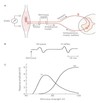Neuromuscular and Spinal Cord Flashcards
(43 cards)
What is the difference between EPSP and IPSP in terms of membrane potential? (excitatory and inhibitory post-synaptic potential)
EPSP – makes the membrane potential less negative (bringing it closerto the threshold potential)
IPSP – makes the membrane potential more negative (hyperpolarisation)
You get graded effects – whether the neurone fires or not is dependent on the summation of inputs ie both EPSP and IPSP will arrive and summate

Which proteins are involved in the release of acetylcholine at synapses?
SNARE proteins
What triggers acetylcholine release? What is the effect of Ach at the postsynaptic motor end plate?
Calcium influx
Causes influx of Na and an AP in the muscle fibre.

If you record the post-synaptic membrane potential (at motor end plates) at any one time, you will see some small changes in membrane potential. What are these caused by?
Miniature end plate potentials
At rest, individual vesicles release ACh at a very low rate causing miniature end-plate potentials (mEPP) - small amounts of ACh trickiling out of vesicles at rest.

What is the difference between intrafusal and extrafusal muscle fibres?
Intrafusal – these are skeletal muscle fibres that serve as sensory organs (proprioceptors) that detect the amount and rate of change of length of a muscle
Extrafusal – standard skeletal muscle fibres that are innervated by alpha motor neurones and generate tension by contracting, thereby allowing for skeletal muscle movement
What are alpha motor neurones? State some other names given to alpha motor neurones.
Anterior horn cells, ventral horn cells or lower motor neurones
They are motor neurones that innervate the extrafusal fibres of skeletal muscle. Activation causes muscle contraction.
Describe the organisation of motor neuron cell bodies in the ventral horn.
Those supplying flexors are more posterior etc.

Describe the arrangement of alpha motor neurones within the ventral horn.
- Dorsal – flexors
- Ventral – extensors
- Medial – proximal
- Lateral - distal
What is the name given to the sensory receptors in muscle that feedback to the CNS and allow an excitatory reflex to be generated?
Spindles
What is a motor neurone pool?
Collection of lower motor neurones that innervate a single muscle
What is an important rule to remember regarding the connections between alpha motor neurones and muscle fibres?
One motor neurone can innervate several muscle fibres
But every muscle fibre can only be innervated by one motor neurone
Under what conditions can this rule be broken?
Under pathological conditions (e.g. severed nerve), the axonal regeneration can result in the innervation of muscle fibres that are already innervated
Define motor unit.
A single motor neurone together with all the muscle fibres that it innervates - it is the smallest functional unit that can generate force.
i.e. FIBRES + its NEURON
Describe and explain the difference in innervation ratio across different muscles in the body using examples.
Muscles that require very fine control (e.g. extrinsic eye muscles) havea low innervation ratio (few fibres innervated by a single neurone)
Muscle that are required to generate a lot of power have a high innervation ratio because when the motor unit fires, it will cause the contraction of a large mass of muscle fibres thus generating power (e.g. quadriceps)
Avg motor neuron nnervates 600 muscle fibres.
What are the 3 types of motor unit?
- Slow (Type 1)
- Fast fatigue-resistant (Type 2A)
- Fast fatiguable (Type 2B)
You will see the differences in muscle fibres types when stained.

Describe the structural and functional differences between slow and fast twitch muscle fibres.
Slow fibres have:
- Smallest diameter cell bodies
- Small dendritic trees
- Thinnest axons
- Slowest conduction velocity
Fast fibres have:
- Larger diameter cell bodies
- Large dendritic cells
- Thicker axons
- Faster conduction velocity

What are 2 methods by which the brain regulates the force that a single muscle can produce?
Recruitment – recruiting more motor units for the muscle contraction
Rate Coding – increasing the frequency of action potentials travelling down the nerves to the muscle fibres
What principle governs recruitment?
Size principle
Smaller units are recruited first, which are generally slow fibres
Describe the order of recruitment of motor units with increasing force generation.
Slow –> Fast Fatigue-Resistant –> Fast Fatiguable
NB: de-recruitement is fast to slow.
What are neurotrophic factors?
Factors produced within the nerves and are transported throughout the nerve to maintain the nerves integrity and function.
They are a type of growth factor that prevents neuronal death and promotes the growth of (peripheral) neurones after injury. This doesn’t happen in the CNS.
What happens to a slow fibre when a fast nerve is transplanted onto it and what does this show?
It becomes fast
This shows that the function of the muscle fibre is very much determined by the type of nerve that innervates it.
The action potentials can’t be the only thing being delivered to the muscles by the nerves.

How easy is it to switch from one motor unit type to another?
Type 2B to Type 2A can happen with training There is usually no way of changing from type 2 to type 1 or vice versa except in the case of severe deconditioning e.g. zero gravity or spinal injury
How does muscle composition change with ageing?
Ageing is associated with a loss of type 1 and type 2 fibres with preferential loss of type 2(fast) fibres
This means that a large proportion of muscle fibres in ages muscle are type 1
This loss of muscle is called sarcopenia
Describe muscle plasticity from exercise and gravity.
Type IIB to IIA most common following training
Type I to II possible in cases of severe deconditioning or spinal cord injury. Microgravity during spaceflight results in shift from slow to fast muscle fibre types








